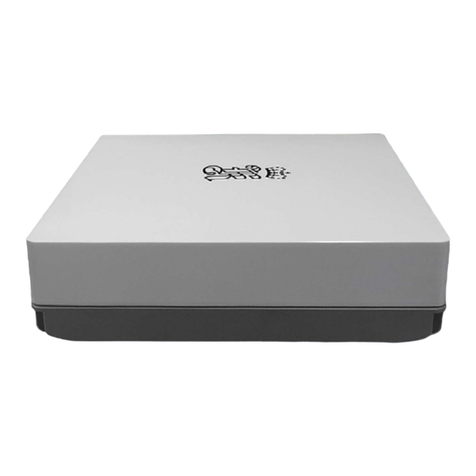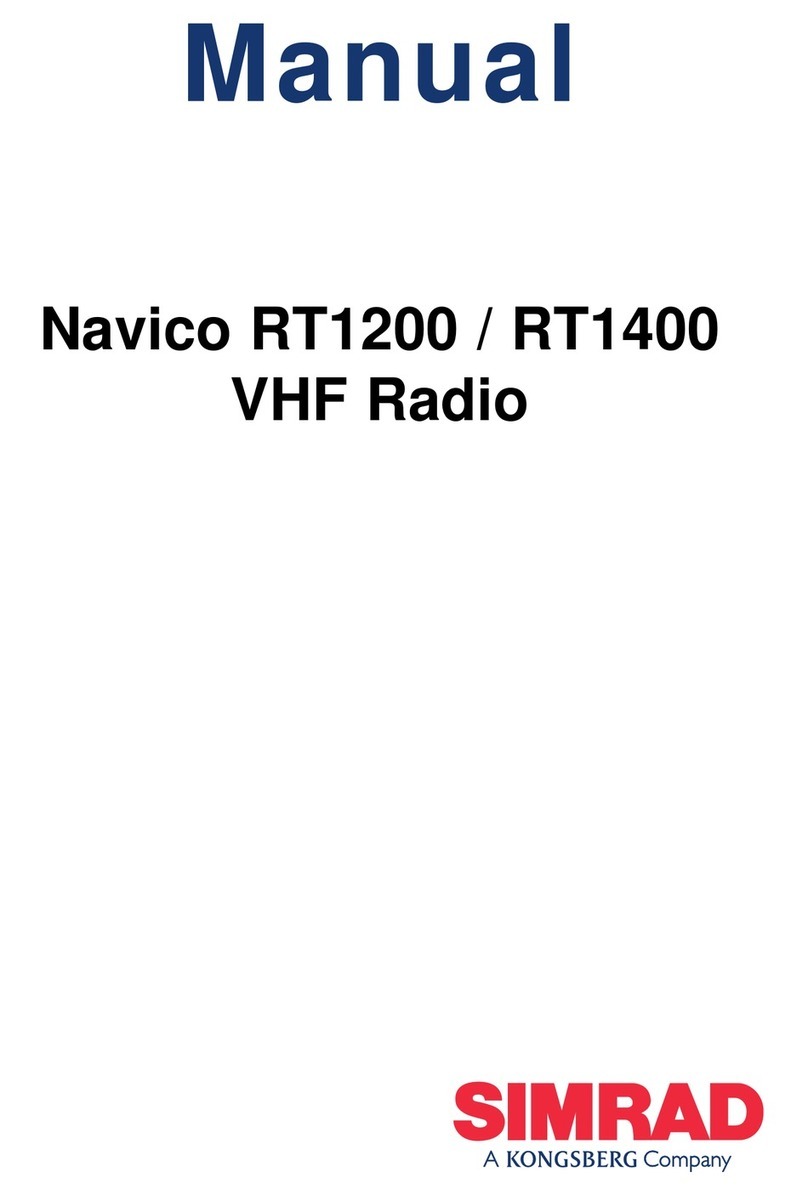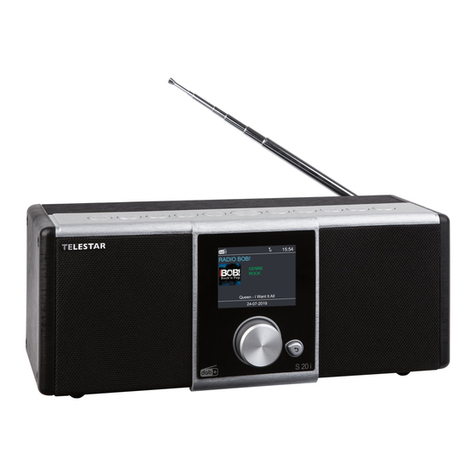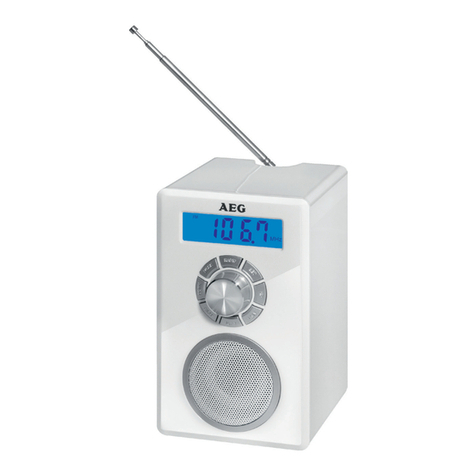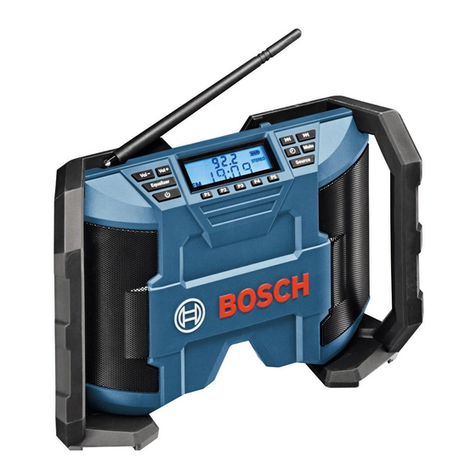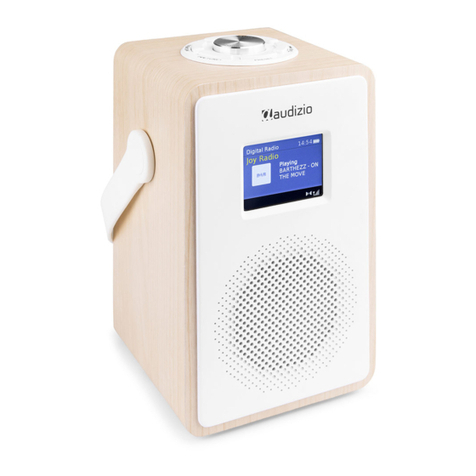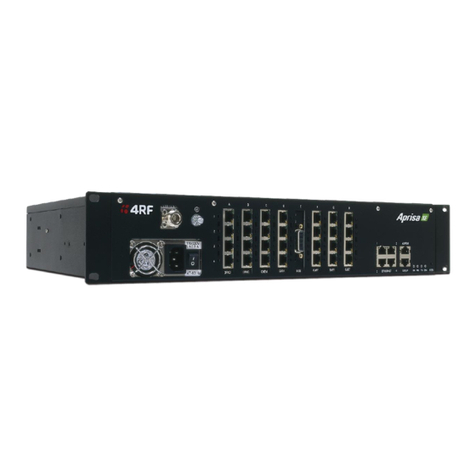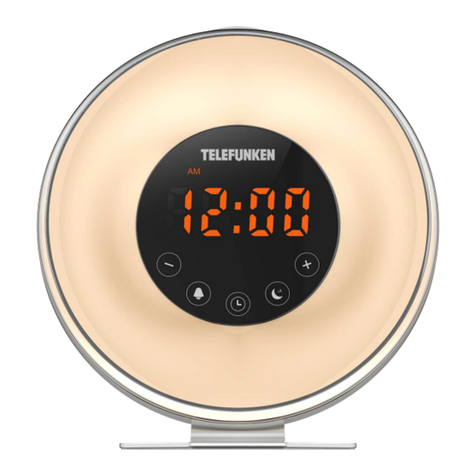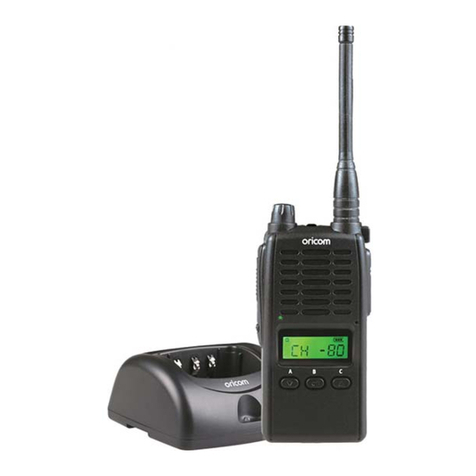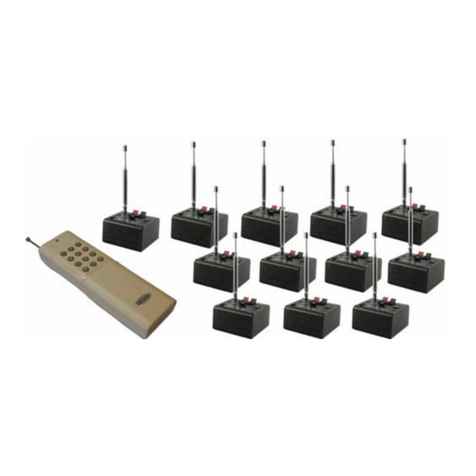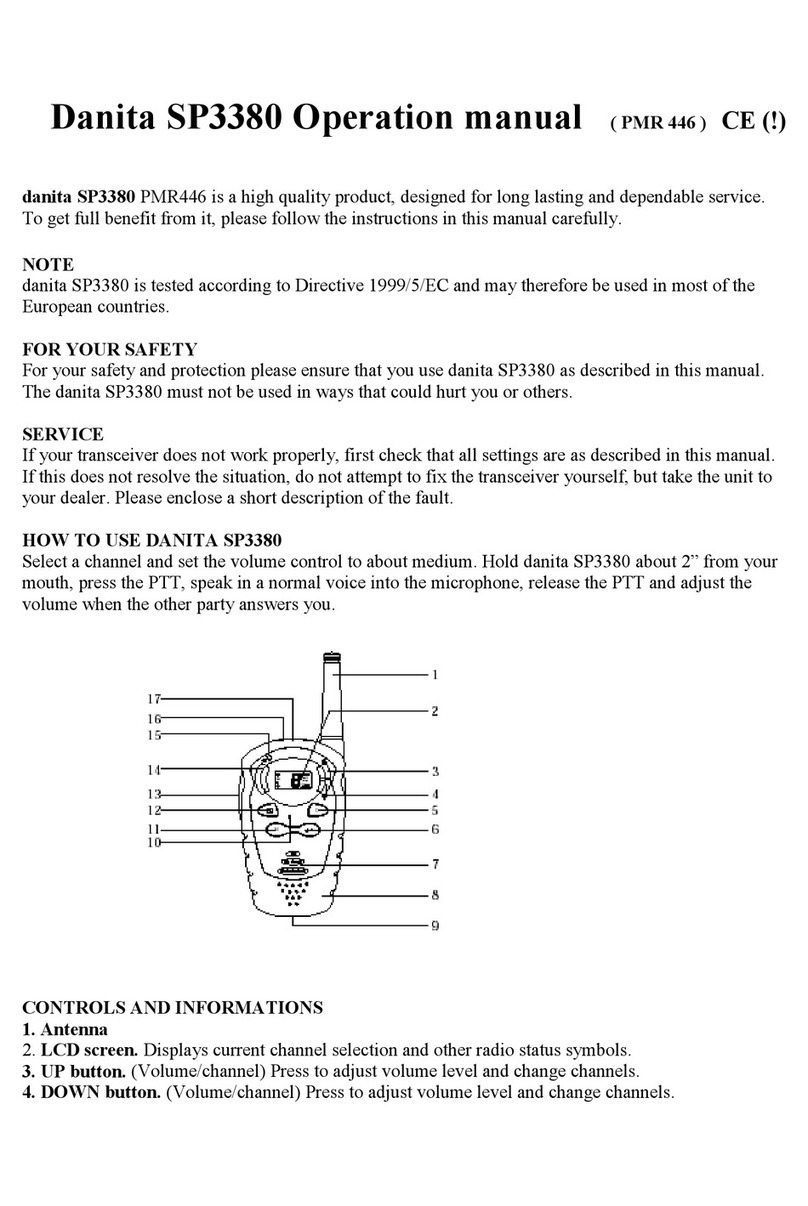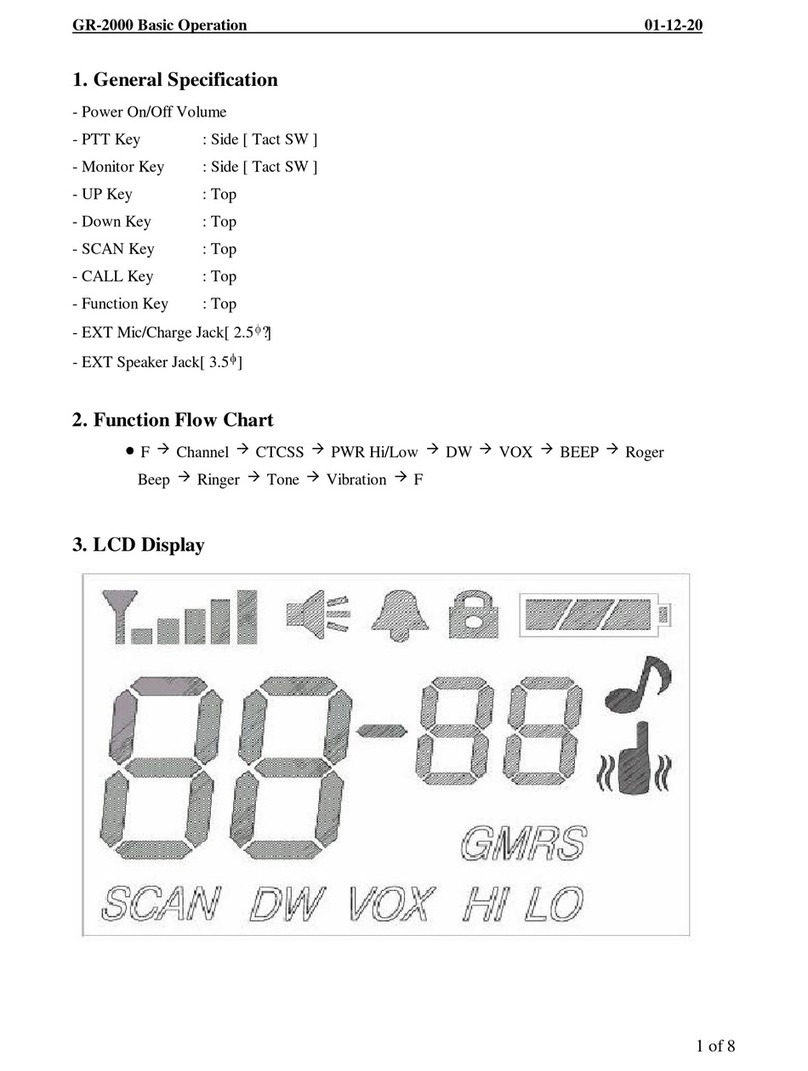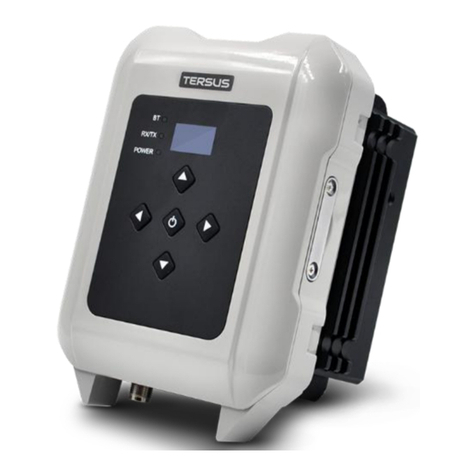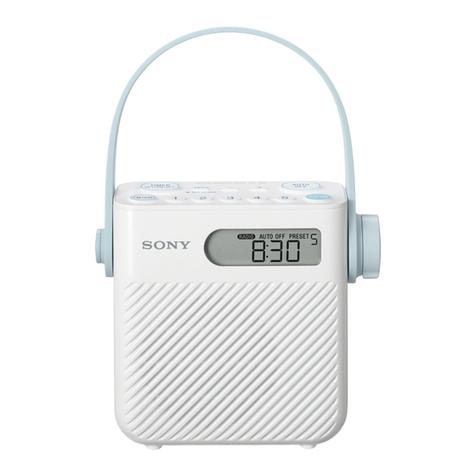Kongsberg Simrad HT50 User manual

MAXIMIZING YOUR PERFORMANCE AT SEA


Instruction Manual
III
E03766 Issue 2.0
Simrad HT50/HT51
Axis 50 GMDSS
Handheld VHF Radios
MANUAL

The technical data, information, and illustrations contained in this publication were to the best of our knowledge correct
at the time of going to print. We reserve the right to change specifications, equipment, installation, and maintenance
instructions without notice as part of our policy of continual development and improvement.
No part of this publication may be reproduced, stored in a retrieval system, or transmitted in any form, electronic, or other-
wise, without prior permission from Simrad Ltd. No liability can be accepted for any inaccuracies or omissions in the pub-
lication. Although every care has been taken to make it as complete and accurate as possible.
Part No. E03766 Issue 2.0 22-Feb-05 CR
© 2005 Simrad Ltd
IV
HT50/HT51/Axis 50 GMDSS

V
E03766 Issue 2.0
1 GENERAL
1.1 Introduction . . . . . . . . . . . . . . . . . . . . . . . . . . . . . . . . . . . . 7
2 OPERATION
2.1 Controls . . . . . . . . . . . . . . . . . . . . . . . . . . . . . . . . . . . . . . 8
2.2 Selecting secondary channel sets . . . . . . . . . . . . . . . . . . . . 11
2.3 Disable/enable key beep . . . . . . . . . . . . . . . . . . . . . . . . . . 12
2.4 Keypad lock . . . . . . . . . . . . . . . . . . . . . . . . . . . . . . . . . . . 12
2.5 Removing and attaching the battery . . . . . . . . . . . . . . . . . . 12
2.6 Charger options . . . . . . . . . . . . . . . . . . . . . . . . . . . . . . . . . 13
2.7 Charging of batteries . . . . . . . . . . . . . . . . . . . . . . . . . . . . . 13
2.8 Battery level indicator . . . . . . . . . . . . . . . . . . . . . . . . . . . . 13
2.9 HT51 accessory socket . . . . . . . . . . . . . . . . . . . . . . . . . . . 14
3 APPENDIX
3.1 Licensing . . . . . . . . . . . . . . . . . . . . . . . . . . . . . . . . . . . . . . 15
3.2 Antenna . . . . . . . . . . . . . . . . . . . . . . . . . . . . . . . . . . . . . . . 16
3.3 Transmission range . . . . . . . . . . . . . . . . . . . . . . . . . . . . . . 16
3.4 Channel frequencies . . . . . . . . . . . . . . . . . . . . . . . . . . . . . 17
3.5 Battery life guidelines . . . . . . . . . . . . . . . . . . . . . . . . . . . . 18
3.6 Troubleshooting . . . . . . . . . . . . . . . . . . . . . . . . . . . . . . . . . 19
3.7 Spares & accessories . . . . . . . . . . . . . . . . . . . . . . . . . . . . . 20
3.8 Technical specification . . . . . . . . . . . . . . . . . . . . . . . . . . . 21
3.9 Declaration of Conformity . . . . . . . . . . . . . . . . . . . . . . . . . 22
3.10 Service & Warranty . . . . . . . . . . . . . . . . . . . . . . . . . . . . . 23
Instruction Manual


1 GENERAL
1.1 Introduction
The Simrad waterproof handheld VHF range comprises three
models:
• The HT50 VHF radio is designed for leisure and light com-
mercial use, and meets or exceeds stringent International
Regulations EN301-178.
• The HT51 model has all the features of the HT50, but
includes an accessory socket for use with fistmikes, headsets,
and other third party accessories.
• The Axis 50 model for GMDSS convention vessels con-
forms to Pan European specification ETS300-225 for the use
of radios for Safety at Sea.
All models are waterproof to IP67 standard.
Please note that regulations vary from country to country.
Simrad sets are approved specifically by the countries in which
they are sold. Consequently, there may be differences in the
programming of sets bought in different countries and, there-
fore, in their associated manuals. If using the radio outside the
country of purchase, it is vital to check that the set conforms to
local regulations before use.
Thank you for choosing Simrad!
If you are pleased with your radio, we hope you will be inter-
ested in our range of marine electronic equipment, which is
manufactured to the same high standards as the HT50. Please
contact your nearest Simrad Agent for a catalog showing our
increasing range of high tech navigational instruments, autopi-
lots, and VHF radio sets.
Simrad operate a policy of continual development and reserve
the right to alter and improve the specification of their products
without notice.
Axis®is a registered trademark of Simrad Ltd.
Instruction Manual
7
E03766 Issue 2.0
HT50 waterproof
handheld VHF

HT50/HT51/Axis 50 GMDSS
8E03766 Issue 2.0
2 OPERATION
2.1 Controls
The location of the controls for the HT50 are shown in Fig 2.1.
Functions:
1 On / Off
2 High / Low power, Keypad lock
3 PTT (Push-To-Talk button)
4 Volume mode select
5 Squelch mode select
6 Up key
7 Down key
8 Scan mode
9 Dual Watch / Tri-Watch
10 Select Priority / Personal channel
11 Backlight On / Off & Light mode select
Fig 2.1 - HT50 controls
1 2
3
4
6
8
10
5
7
9
11

Hold
during
Power Up
Select secondary
channel set*
Disable / enable
first key beep
*If available
Press & hold
Triple
Beep
Inhibit / enable
selected channel
from scan
Set Personal
channel
Instruction Manual
9
E03766 Issue 2.0
Pressing and holding certain keys will access additional func-
tions. These are indicated by a double beep, or a triple beep if
held for longer (Table 1).
Key
VOL
SQ
▲
▼
SCAN
D/W
16
Hi/Lo
Press
1x
Select Volume mode
Select Squelch mode
Standard mode
Channel Up / Down
Volume mode
Volume Up / Down
Squelch mode
Squelch Up / Down
Light mode
Light level Up / Down
Memory Scan
Dual Watch
Select channel 16
Select Light mode
Backlight On/Off
Select 1 or 5 Watts
Press
2x
Add / delete
channel from
Memory Scan
Press & hold
Double
Beep
Scan All Channels
Tri-Watch
Select Personal
channel
Engage / disable
keypad lock
Table 1 - Additional functions, overview

On/Off (1)
Press to turn the HT50 on. To turn the radio off, press and
hold the key for approximately 2 seconds. This is to avoid acci-
dental power off.
Hi/Lo (2)
Toggles between high and low transmit power (see specification
section 3.8). Use the low setting over short ranges to preserve
battery power.
VOL – Volume (4) & SQ – Squelch (5)
Press to select Volume or Squelch mode then use the ▲and ▼
keys to adjust the level.
The display shows “VOL” or “SQL” for 3 seconds – if ▲or ▼
are not pressed within this time, their function reverts to channel
select.
▲ / ▼(6 & 7)
These keys will change the selected channel. Pressing VOL,
SQ, or , then
▲/▼within 3 seconds will adjust the volume,
squelch, or backlighting level respectively. The bargraph will
indicate the level selected.
SCAN mode (8)
Scans through the channels stored in the channel memory (dis-
play shows “MEM SCAN”).
• Select channel and press twice to add to/delete from Mem-
ory Scan (display shows “ENT” or “DEL” respectively).
HT50/HT51/Axis 50 GMDSS
10 E03766 Issue 2.0
abcd
fgi
e
Fig 2.2 - HT50 display functions
a Bar graph –
Power up Battery level
Standby Battery level
Transmit Battery level
Volume mode Volume level
Squelch mode Squelch level
pressed Backlight level
b Personal channel indicator
c Channel selected
d Receiving or transmitting indicator
e High or Low power indicator
f Function indicator
g Selected channel stored in memory
h Channel inhibited from scan
i Scan mode selected
h

Instruction Manual
11
E03766 Issue 2.0
• The icon indicates that the selected channel is included
in Memory Scan.
• Press and hold until double beep sounds to scan all chan-
nels (display shows “SCAN”).
• Press and hold until triple beep sounds to inhibit/enable
selected channel from scan (display shows “INH” or “ENA”
respectively). The icon indicates the channel is inhibited.
D/W - Dual Watch & T/W – Tri-Watch (9)
• Press to select Dual Watch of selected channel and Ch16
(the display shows “D/W”).
• Press and hold until double beep sounds for Tri-Watch –
selected channel, personal channel, and channel 16 (the dis-
play shows “T/W”).
16 - Channel 16 / Personal Channel (10)
• Press to select channel 16.
• Press and hold until double beep to select personal channel
(display shows ).
• Press and hold for three beeps to set selected channel as
the personal channel.
- Backlight (11)
• Press to turn on and off. Use ▲/▼to adjust the backlighting
level (5 levels available). The bargraph indicates the back-
lighting level.
• The battery save function turns the backlighting off if no key
is pressed after 20 seconds. Press any key (except or ) to
turn the light on again.
2.2 Selecting secondary channel
sets
In countries where it is permitted, holding VOL down while
turning the radio on will enable the radio to operate on a
secondary set of channels (Fig 2.3).
Where the display will normally show “INT” (International
channel set) on the bottom line, this will show “USA” for USA
channels, “CAN” for Canadian channels, etc.
• Channel sets available will depend on which country the
radio is programmed for use in. This function will only be
available if permitted in the country of purchase (for details
refer to sections 3.1 and 3.4).
• The radio will revert to International channels if it is
switched off, then on again.
Keep VOL pressed
Fig 2.3 - Selecting alternative
channel sets

2.3 Disable/enable key beep
The HT50 beeps every time a key is pressed to confirm opera-
tion. To disable the key beep, press and hold SQ while turning
the set on. Repeat this procedure to turn the key beep on again.
Second level functions (such as All Channel Scan, Tri-Watch,
etc.) will still be indicated by a beep, even if the key beep is
disabled.
2.4 Keypad lock
The HT50 keypad can be locked to prevent accidentally press-
ing keys while in a pocket, etc.
To lock the keypad, press and hold the Hi/Lo key. The HT50
will beep twice and any key pressed will not function – “LOCK”
will appear in the display. To disengage the keypad lock, press
and hold Hi/Lo again.
Note The PTT key will still function when the keypad lock is on,
allowing transmitting and receiving as normal.
Note This function is not available with the Axis 50 GMDSS models
(yellow case).
2.5 Removing and attaching the battery
The HT50 is supplied with a 1200mAh NiMH battery (part no.
NH12). The Axis 50 GMDSS radio has two battery options: an
850mAh NiCad (NC08) or a non-rechargeable Lithium battery
(LTB3).
The batteries are supplied with a label across the contacts to
prevent accidental discharge while in the box. This label should
be removed before use.
To remove the battery, lift the two locking clips holding the
battery pack in place (Fig 2.4). When reattaching, ensure the
two locating pegs on the top of the battery are located into the
slots in the radio and that the two locking clips have both
engaged.
The set is fully waterproof, even with the battery removed, but it
is recommended that any moisture on the top of the battery or in
the battery compartment is wiped clear before attaching, to pre-
vent the water creating a conductive path between the contacts
and reducing battery life.
Note Axis 50 batteries cannot be used with an HT50, and vice versa.
HT50/HT51/Axis 50 GMDSS
12 E03766 Issue 2.0
Fig 2.4 - Battery pack removal

Instruction Manual
13
E03766 Issue 2.0
2.6 Charger options
The HT50 is supplied with a TC50 trickle charger that will
accept the whole radio or the battery only. The TC50 runs from
a 12.6V–15.5V DC supply or from AC mains with an appropri-
ate optional adaptor/power supply. Charging with the trickle
charger takes approximately 12–16 hours. There is also a rapid
charger available (RC50) which will charge the battery within
11/2hours.
2.7 Charging of batteries
To charge the NiCad and NiMH battery packs, insert the battery
or radio into the charger ensuring that any moisture is wiped
from the contacts on the back of the battery pack. The TC50
will trickle charge the battery to full capacity (Fig 2.5). The
RC50 will rapid charge the battery until it is fully charged and
will then automatically switch to maintenance charge.
• Note that batteries are supplied uncharged and must be
fully charged before use.
• Fully charge the battery when not in use, though it may
lose some of its charge after several months of storage.
• Do not charge at temperatures below 0ºC or above 40ºC.
• Turn off radio when charging the battery.
• Regularly discharge the battery totally – repeated recharg-
ing of the battery while it is only partly discharged may cre-
ate a ‘memory effect’, preventing it reaching full charge.
• Dispose of used batteries carefully. The contents of the bat-
teries could be harmful to the environment.
• Never expose to a naked flame.
Caution The LTB3 Lithium battery is not rechargeable and under no
circumstances should any attempt be made to recharge it.
Replacement batteries can be ordered from your local
Simrad Agent.
2.8 Battery level indicator
Except when adjusting the Volume or Squelch level, the bar
graph on the display shows the battery charge level (Fig 2.6).
This indicates the voltage at the battery terminals, not necessar-
ily the charge stored. Ten or nine bars indicate a fully charged
battery, three or four bars mean the battery is almost drained.
A more accurate indication of the battery state will be obtained
by transmitting briefly on high power. Do not use Ch16 for
this purpose.
Fig 2.5 - Battery charger
Fig 2.6 - Battery level indicator

HT50/HT51/Axis 50 GMDSS
14 E04586 Issue 2.0
When using a lithium battery pack, the low-level battery indi-
cator may flash under transmit conditions. This does not neces-
sarily reflect the charge level remaining in the battery, as it is
due to the different voltage characteristics of a Lithium battery
pack under load.
2.9 HT51 accessory socket
The HT51 features an accessory socket (Fig 2.7) for use with
fistmikes, headsets, and boom-mikes, etc. The features, func-
tionality, and operation of the HT51 are identical to the HT50.
Only accessories made specifically for use with the HT51
should be connected – incompatible accessories could damage
the radio and invalidate the warranty.
Switch off the radio before connecting an accessory to the
socket.
Note that the HT51’s internal speaker, microphone, and PTT
button are disabled when the accessory is connected – these
functions are transferred to the accessory.
For details of compatible accessories available, please contact
your Simrad Distributor or the Simrad Preferred Supplier:
Atlantic Instruments
The Coach House
Trefor
Holyhead
Anglesey LL65 1LZ
United Kingdom
Contact:
Charles Mortlock
Mobile: +44 (0)7761 494384
Phone: +44 (0)1407 720513
Fax: +44 (0)1407 720616
E-mail: [email protected]
Website: www.atlanticuk.com
Fig 2.7 - HT51 with
accessory socket

3 APPENDIX
3.1 Licensing
Note Prior to use please check the national licensing requirements
for operators.
In the UK license applications and queries should be made to
the following authority:
Ship Radio Licencing
Radio Licencing Centre
The Post Office
P.O. Box 1495
Bristol BS99 3QS
Website: www.radiolicencecentre.co.uk/rlc
A set may only be operated by or under the supervision of the
holder of a Marine Radio Operator’s Certificate of Competence
and Authority to Operate. This is awarded on completion of the
Marine Short Range Certificate course administered by the Royal
Yachting Association:
Royal Yachting Association
RYA House
Ensign Way
Hamble
Southampton SO31 4YA
Website: www.rya.org.uk
Tel. 0845 345 0400
Holders of the Restricted Certificate of Competence in Radio-
telephony (which covers MF/HF SSB, etc.) do not need a sepa-
rate VHF certificate.
In all other countries, please contact your regional authority for
information.
WARNING North American Users – FCC*regulations require
that members of the general public should not be
exposed to excessive levels of radio frequency
radiation. To comply with the specified limits it is
recommended that this radio is operated in such
a manner as to limit transmission to no more
than five minutes in any half hour period and that
the antenna is kept at least 8 in (20 cm) from any
part of the body during transmission.
*Federal Communications Commission
Instruction Manual
15
E03766 Issue 2.0

HT50/HT51/Axis 50 GMDSS
16 E03766 Issue 2.0
3.2 Antenna
The antenna for the radio is fitted to the unit via a robust screw
fitting to an M6 threaded socket on the top of the radio. This
system is more rugged than a traditional BNC connector, so the
radio’s drop-proof integrity is not compromised by the antenna
fixing. While the radio is drop-proof and very robust, damage
to the antenna such as bending or kinking may adversely affect
the transmission efficiency of the unit, which may lead to over-
loading of the power module. Damaged antennas should be
replaced immediately.
➞
Replacement antennas can be obtained from authorized
Simrad Agents. Please refer to section 3.7 for more details.
3.3 Transmission range
Because VHF signals travel in a straight line and are not
reflected back off the ionosphere as lower frequency signals are,
the range of VHF signals is limited to ‘line of sight’, beyond
which the other vessel passes behind the curve of the Earth.
Therefore, the range will increase greatly the higher above sea
level the antenna is positioned, as Fig 3.1 illustrates (assuming
maximum transmission power is used):
The typical range of a handheld radio such as this one used at
sea level will be approximately 8 km (5 miles). This will increase
as height above sea level increases, or if the other radio user’s
antenna is at a greater height – note that the range between the
yacht with the antenna mounted on a 9 m (30 ft) mast and the
handheld user increases to 13–16 km (8–10 miles).
Fig 3.1 - Transmission ranges

Instruction Manual
17
E03766 Issue 2.0
3.4 Channel frequencies
Note Ch 0 will only be made available in the UK to Coastguard
users with written authorization.
Ch 70 is restricted for DSC (Digital Selective Calling) use only
and is therefore not available on the HT50 or Axis 50 VHF
radio. Axis 50 GMDSS models are fitted with simplex channels
only.

BATTERY PACK Typical life of fully charged pack at 25°C
Duty Cycle Ai Duty Cycle Aii Duty Cycle B
850mAh NiCad 9 hrs 12 hrs 5 hrs
1200mAh NimH 12 hrs 20 hrs 7 hrs
HT50/HT51/Axis 50 GMDSS
18 E03766 Issue 2.0
3.5 Battery life guidelines
New batteries should be fully (trickle) charged and fully dis-
charged several times to achieve full capacity.
To a large extent, the battery life will depend on the usage, or
Duty Cycle, of the radio (Tables 2 and 3), i.e. the battery will
be drained much quicker if the radio is transmitting continually
than if it is just receiving. Additionally, if the radio is set to
High power (5 Watts*), the power drain will be considerably
greater than if transmitting on Low power (1 Watt*).
*Standard power settings
Ai Based on - 5% Transmit at 5 Watt setting of r.f. output power (1.4 Amp)
5% Receive at 200 mWatts Audio (0.15 Amp)
90% Receiver squelched (0.02 Amp)
Aii Based on - 5% Transmit at 1 Watt setting of r.f. output power (0.8Amp)
5% Receive at 200 mWatts Audio (0.15 Amp)
90% Receiver squelched (0.02 Amp)
BBased on - 10% Transmit at 5 Watts setting of r.f. output power (1.4 Amp)
10% Receiver at 250 mWatts Audio (0.15Amp)
80% Receiver squelched (0.02 Amp)
Table 2 - Battery life values predicted from calculation:
BATTERY PACK Duration
At 25ºCAt45
ºC
850mAh NiCad Up to 50% charge 4–6 months 4 weeks
1200mAh NimH Up to 50% charge 4 months 4 weeks
Table 3 - Battery charge held while stored
The following data is approximate:

Instruction Manual
19
E03766 Issue 2.0
3.6 Troubleshooting
These simple checks should be carried out before seeking tech-
nical assistance and may save time and expense.
Before contacting your servicing agent please obtain the radio’s
serial number and the software iteration – this is shown in the
large digits on the display for 2 seconds after the radio is turned
on.
Symptom Possible cause Remedy
Unit will not switch on • Battery not charged • Re-charge battery
• Battery not attached correctly • Ensure battery is fully
to radio engaged (see section
2.5)
Scan or Memory Scan • Noise on the channel is • Increase squelch level
is locking on a channel holding the scan • Inhibit channel from
without a signal scan
Dual Watch not being • Priority channel selected • Select a working
entered (normally channel 16) channel
Cannot change channel • Dual Watch (D/W) engaged • Exit Dual Watch
Certain channel numbers • Some channels are restricted • Consult your national
are not obtainable and programmed depending authority for permitted
on country of purchase channels in your region
Will not transmit • Scanning or D/W function active • Exit D/W or scan
Will not transmit on 5W • Low voltage when full transmit- • Battery charge low –
but OK on 1W ting current is drawn recharge the battery
• Some channels are restricted to • Consult your national
low power transmission only authority
Transmissions are • Damaged antenna • Replace antenna
persistently weak

HT50/HT51/Axis 50 GMDSS
20 E03766 Issue 2.0
3.7 Spares & accessories
The following spares and accessories are available from author-
ized Simrad Service Agents. Please quote the relevant part
number when ordering.
ANT3
Spare Antenna
Axis 50 GMDSS Batteries –
NC08
850 mAh NiCad Battery Pack
LTB3
Lithium Battery Pack
(Non-rechargeable)
HT50 Batteries –
NH12
1200 mAh NimH Battery Pack
TC50
Trickle Charger
RC50
Rapid Charger
MAT50:U (UK)
MAT50:E (Europe)
MAT50:A (USA)
Mains Adaptors for TC50
MAR50:U (UK)
MAR50:E (Europe)
MAR50:A (USA)
Mains Adaptors for RC50
This manual suits for next models
2
Table of contents
Other Kongsberg Radio manuals




